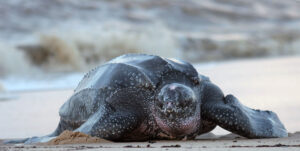NC State Veterinary Medicine Research Roundup, October 2021

A look at some of the latest published studies from the CVM.
Dogs and Storm Anxiety
Twice daily administration of the anticonvulsant imepitoin decreased anxiety scores in dogs with storm anxiety, according to a new study.
Researchers studied the impact of imepitoin, sold under the brand name Pexion, compared to placebo by having owners rate their dog’s anxiety intensity and frequency within 16 separate behaviors. Imepitoin was found to be significantly superior to placebo in storm logs and weekly surveys, with owners of dogs in the imepitoin group far more likely to report that the treatment reduced their dog’s fear and anxiety during storms compared to placebo.
Though storm anxiety is often grouped with other noise aversions for dogs, fearful behavior during storms is considered more complex than noise aversion alone. Authors of the research, published in Vet Record, include Margaret Gruen, Brianna Johnson, Carrie Emke and Irina Perdew.
Read the study here.
Targeting Heart Injury
Mesenchymal stem cell exosomes have shown particular promise in treating myocardial infarction.
A new study hybridizing stem-cell-derived exosomes with platelet membranes finds the process enhances an exosome’s ability to target an injured heart. Researchers found that platelet membrane modification both enhanced the accumulation of exosomes in injured tissues and substantially enhanced cellular internalization of exosomes.
The proof-of-concept data showcases a simple, fast and translatable approach to modify therapeutic exosomes to make them disease targetable. Nano Today published the research, with authors including Ke Cheng, Teng Su, Xiao Cheng, Junlang Li, Jhon Cores, Dashuai Zhu, Zhenhua Li, Xianyun Wang and Shiqi Hu.
Read the study here.
Ozone and Bronchial Hyperactivity
Research with authors including Glenn Cruse and Barry Hedgespeth pinpointed a receptor on mast cells and other cell types that contributes to bronchial hyperactivity triggered by ozone, an environmental pollutant.
The study demonstrates that ozone induces the substantial release of the energy-providing compound adenosine triphosphate (ATP) from human airway epithelia in vitro and into the airways of mice in vivo, and that ATP is a potent inducer of mast cell degranulation and bronchial hyperactivity by acting through P2X7 receptors on mast cells.
Ozone has well-recognized adverse effects on lung health and bronchial hyperactivity is one consequence of ozone exposure, especially for people with underlying lung disease. JCI Insight published the research.
Read the study here.
Sea Turtles and Gas Embolism Risk
A new baseline model for estimating the risk of gas embolism (GE) in sea turtles, finds that the animals are at high risk for GE even during routine diving behavior.
Sea turtles commonly experience significant gas embolism, when blood vessels are blocked by bubbles of air or other gas in the circulatory system when caught at depth in fishing gear and brought to the surface. Researchers developed a mathematical model to estimate pressures of nitrogen, oxygen and carbon dioxide in major body compartments of diving loggerheads, leatherbacks and green turtles.
The model suggests that cardiac output likely plays a significant role in GE modulation. Since the GE risk is high even during routine dives, it’s likely that turtles have additional behavioral, anatomical or physiological adaptations that work to reduce the probability of GE. Such findings help to reveal the overall factors driving GE in sea turtles.
Craig Harms is one of the authors of the study published in Frontiers in Physiology.
Read the study here.
Canine Blood Collection Techniques
Accurate hemostatic variables in healthy dogs may be obtained using blood collected from indwelling jugular catheters maintained with heparinized saline for at least 72 hours, according to new research.
Researchers compared variables performed on blood samples from jugular catheters and direct venipuncture. No significant differences were identified in the variables obtained by either blood collection technique.
Yu Ueda, Kady Castaneda, Laura Ruterbories and Alex Lynch are among the authors of the research, published in the Journal of Veterinary Emergency and Critical Care.
Read the study here.
Controlling African Swine Fever
A proposed framework evaluating the epidemic potential of African swine fever (ASF) outlines quarantine-based control strategies that could assist animal health authorities in planning a national preparedness and response plan for ASF.
Since there is no effective vaccine for the disease, control strategies are heavily dependent on mass depopulation and movement restrictions. Researchers, including Gustavo Machado, Trevor Farthing and Cristina Lanzas, developed a multiscale model for transmission of ASF, modeling outcomes of epidemic duration, the number of secondary infected farms and pigs and the distance of ASF spread.
BioRxiv published the study.
Read the study here.
Treating Feline Joint Disease
New research finds that the nonsteroidal anti-inflammatory drug robenacoxib shows promise in treating cats with degenerative joint disease-associated pain.
Compared to placebo, mean total activity was higher in robenacoxib-treated cats and more cats treated with the drug had a greater than 10% increase in activity after three and six weeks. Robenacoxib also improved temperament and happiness after six weeks.
Degenerative joint disease and osteoarthritis affect up to 90% of cats across all ages. Pinpointing effective treatments for cats with degenerative joint disease pain is challenging since signs may be relatively subtle.
Authors of the research, published in Scientific Reports, include Duncan Lascelles, Margaret Gruen and CVM Ph.D. graduate Derek Adrian.
Read the study here.
Pathogens in Free-Roaming Cats
A study of the prevalence of vector-borne pathogens in tissue samples from free-roaming domestic cats in the south Atlantic region of the United States offers insight into infection rates and potential for disease transmission.
Researchers surveyed ear tip and reproductive tissues from free-roaming cats from two locations for Anaplasma, Bartonella, Ehrlichia, hemotropic Mycoplasma and Rickettsia species. Bartonella species infection was found to be more common in cats from North Carolina than Virginia.
The findings also suggest that Bartonella henselae is more common in cats’ reproductive tissue, reinforcing the importance of investigating the potential for B. henselae vertical transmission, the passing of a pathogen from mother to baby right before or after birth, or induction of reproductive failure.
The study’s authors are CVM Ph.D. graduate Erin Lashnits, Ed Breitschwerdt, Ricardo Maggi, Kelli Ferris and Charlotte Manvell.
Read the study here.
~Jordan Bartel/NC State Veterinary Medicine


